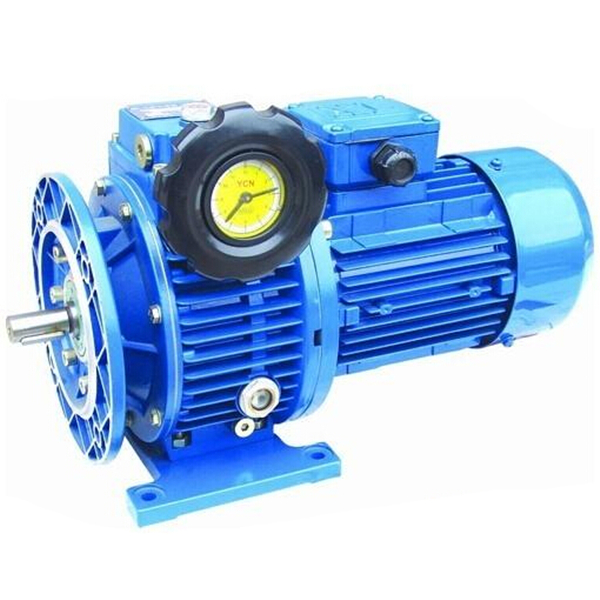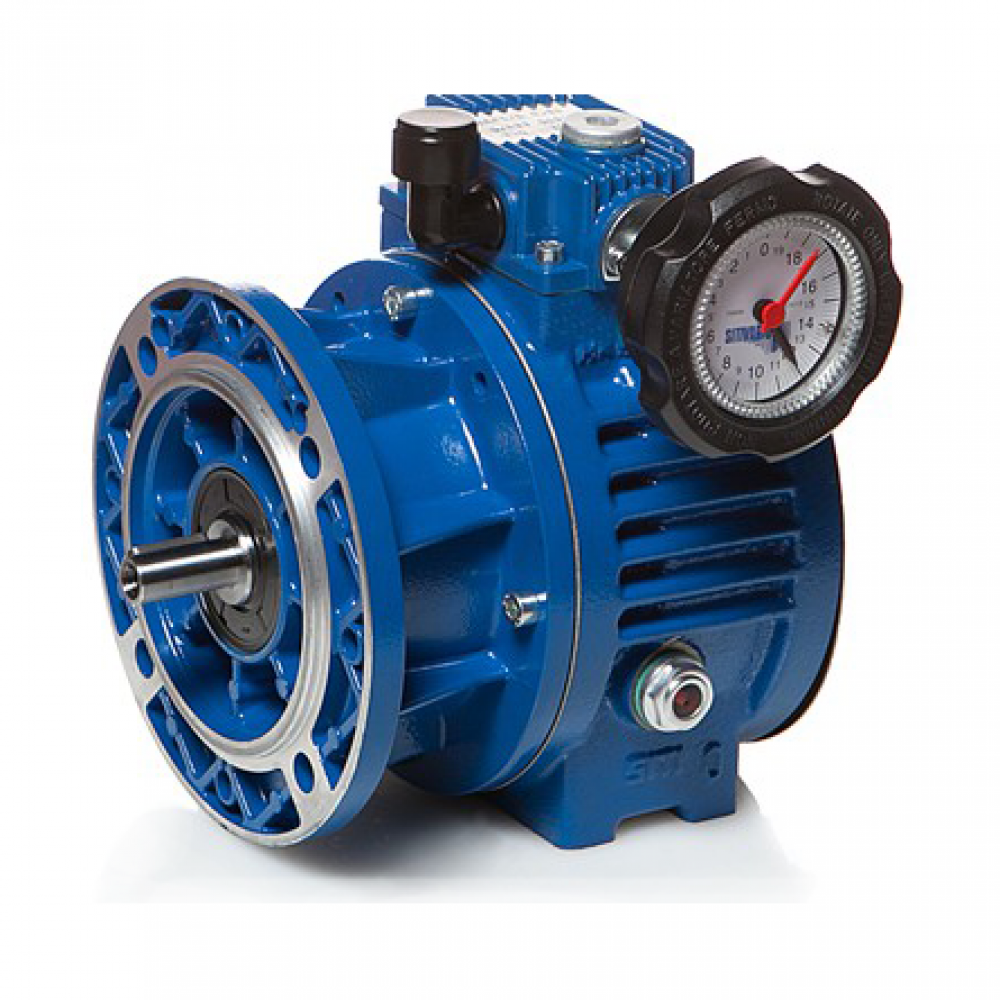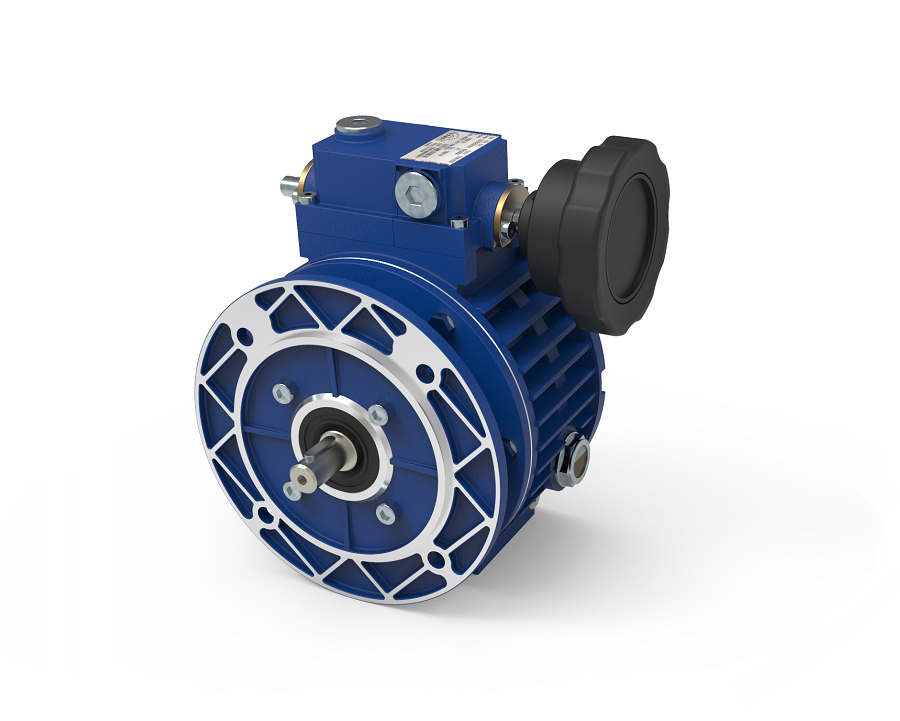Product Description
JWB Series Speed Variator
1. Features:
JWB-X type
- Sizes: ≥04
- Power up to 1.5 kW or more
- Cases in RAL 5571 blue cast iron
- Shafts: case hardened and tempered steel.
- Internal components: heat-treated steel
- Output speed with 4 pole(1400r/min) motors: 2-10r/min;4.7-23.5r/min;15-75r/min;20-100r/min, 28-140r/min, 30-150r/min;40-200r/min;60-300r/min;80-400r/min;100-500r/min;190-950r/min.
- Output Torque value max 1002Nm
- Silent, vibration-free running
- Bidirectional rotation
- Control handwheel positionable on either side
- Slipping speed to max load at 5%
- Regulation sensibility: 0,5 rpm
- Painted with blue epoxy-polyester powder
JWB-X B type
- Sizes:01,02,03 and 04
- Power up to 1.5 kW or less
- Cases in die-cast aluminium alloy
- Shafts: case hardened and tempered steel.
- Internal components: heat-treated steel
- Output speed with 4 pole(1400r/min) motors: 2r/min-20r/min;4.7r/min-23.5r/min;6.5-32.5r/min, 8-40r/min, 9-45r/min, 13-65r/min, 15r/min-75r/min;18-90r/min, 25-125r/min, 28r/min-140r/min;40r/min-200r/min;60r/min-300r/min;80r/min-400r/min;100r/min-500r/min;190r/min-950r/min.
- Output Torque value max 795 Nm
- Silent, vibration-free running
- Bidirectional rotation
- Control hand wheel positionable on either side
- Slipping speed to max load at 5%
- Regulation sensibility: 0,5 rpm
- Painted with blue epoxy-polyester powder
2. Technical parameters
| Type | Output Torque | Output Shaft Dia. | Output Speed Range | 2rpm-950rpm | |
| SWB01 | 2.6-1.6N.m | φ11 | Applicable Motor Power | 0.18kW-7.5kW | |
| SWB02 | 258-1.8N.m | φ14,φ24,φ28,φ32 | |||
| SWB03 | 426-4N.m | φ24,φ28,φ38 | Input Options | With Inline AC Motor | |
| SWB04 | 795-8N.m | φ28,φ38,φ42 | With IEC Motor | ||
| SWB05 | 535-16N.m | φ38,φ48,φ55 | With Input Shaft | ||
| SWB06 | 1002-40N.m | φ42,φ55,φ70 | With Input Flange | ||
About Us
ZheJiang CHINAMFG Drive Co.,Ltd,the predecessor was a state-owned military mould enterprise, was established in 1965. CHINAMFG specializes in the complete power transmission solution for high-end equipment manufacturing industries based on the aim of “Platform Product, Application Design and Professional Service”.
CHINAMFG have a strong technical force with over 350 employees at present, including over 30 engineering technicians, 30 quality inspectors, covering an area of 80000 square CHINAMFG and kinds of advanced processing machines and testing equipments. We have a good foundation for the industry application development and service of high-end speed reducers & variators owning to the provincial engineering technology research center,the lab of gear speed reducers, and the base of modern R&D.
Our Team
Quality Control
Quality:Insist on Improvement,Strive for Excellence With the development of equipment manufacturing indurstry,customer never satirsfy with the current quality of our products,on the contrary,wcreate the value of quality.
Quality policy:to enhance the overall level in the field of power transmission
Quality View:Continuous Improvement , pursuit of excellence
Quality Philosophy:Quality creates value
3. Incoming Quality Control
To establish the AQL acceptable level of incoming material control, to provide the material for the whole inspection, sampling, immunity. On the acceptance of qualified products to warehousing, substandard goods to take return, check, rework, rework inspection; responsible for tracking bad, to monitor the supplier to take corrective
measures to prevent recurrence.
4. Process Quality Control
The manufacturing site of the first examination, inspection and final inspection, sampling according to the requirements of some projects, judging the quality change trend;
found abnormal phenomenon of manufacturing, and supervise the production department to improve, eliminate the abnormal phenomenon or state.
5. FQC(Final QC)
After the manufacturing department will complete the product, stand in the customer’s position on the finished product quality verification, in order to ensure the quality of
customer expectations and needs.
6. OQC(Outgoing QC)
After the product sample inspection to determine the qualified, allowing storage, but when the finished product from the warehouse before the formal delivery of the goods, there is a check, this is called the shipment inspection.Check content:In the warehouse storage and transfer status to confirm, while confirming the delivery of the
product is a product inspection to determine the qualified products.
7. Certification.
Packing
Delivery
/* January 22, 2571 19:08:37 */!function(){function s(e,r){var a,o={};try{e&&e.split(“,”).forEach(function(e,t){e&&(a=e.match(/(.*?):(.*)$/))&&1
| Application: | Motor, Machinery, Agricultural Machinery, Ceramic |
|---|---|
| Hardness: | Hardened Tooth Surface |
| Installation: | Vertical or Horizotal Type |
| Layout: | Coaxial |
| Gear Shape: | Planetary Conedisk Friction Type |
| Step: | Stepless |
| Customization: |
Available
|
|
|---|

How does the design of variators contribute to energy savings and reduced emissions?
Variators are designed with several key features and mechanisms that contribute to energy savings and reduced emissions. These design aspects focus on optimizing power transmission efficiency, reducing mechanical losses, and enabling better control over the powertrain. Here’s a detailed explanation of how the design of variators contributes to energy savings and reduced emissions:
1. Continuously Variable Transmission (CVT) Design:
Variators, particularly those used in CVTs, offer a continuously variable gear ratio, allowing the engine to operate at its most efficient speed for a given driving condition. Unlike traditional transmissions with fixed gear ratios, CVTs enable the engine to stay within its optimal power band, resulting in improved fuel efficiency. The continuously variable nature of CVTs ensures that the engine can maintain an optimal RPM (revolutions per minute) regardless of the vehicle speed, reducing unnecessary fuel consumption and emissions.
2. Friction Reduction:
Variators are designed to minimize friction and mechanical losses in the power transmission system. Friction reduction measures, such as the use of low-friction materials, improved lubrication systems, and optimized bearing designs, help to minimize energy losses during power transmission. By reducing friction, variators improve the overall efficiency of the powertrain, allowing more energy from the engine to be effectively transferred to the wheels or driven machinery, resulting in energy savings and reduced emissions.
3. Lightweight Construction:
The design of variators focuses on lightweight construction using materials that offer high strength and durability. By reducing the weight of variators, the overall weight of the vehicle or machinery can be reduced. A lighter vehicle or machinery requires less energy to accelerate, decelerate, and operate, resulting in improved energy efficiency. Additionally, lighter components in variators also contribute to reduced mechanical losses and improved overall system efficiency.
4. Efficient Power Flow:
Variators are designed to ensure efficient power flow from the engine to the wheels or driven machinery. They are engineered to minimize power losses during transmission, ensuring that a maximum amount of power is delivered to the wheels or machinery. By optimizing power flow, variators help to reduce energy waste and improve overall energy efficiency, resulting in energy savings and reduced emissions.
5. Advanced Control Systems:
Modern variators often incorporate advanced control systems that optimize power delivery and engine operation. These control systems continuously monitor various parameters, such as throttle input, vehicle speed, and engine load, and adjust the gear ratio accordingly. By precisely controlling the powertrain, variators help to minimize unnecessary fuel consumption and emissions. Additionally, advanced control systems can also facilitate regenerative braking and energy recovery, further enhancing energy savings and reducing emissions.
6. Integration with Hybrid and Electric Powertrains:
Variators are designed to integrate seamlessly with hybrid and electric powertrains. In hybrid vehicles, variators play a crucial role in efficiently transferring power between the internal combustion engine and the electric motor. They enable smooth transitions between different power sources, optimizing energy usage and reducing emissions. In electric vehicles, variators are often used in conjunction with single-speed transmissions to provide efficient power delivery from the electric motor to the wheels, contributing to energy savings and reduced emissions.
7. Compliance with Emission Regulations:
The design of variators takes into account emission regulations and standards imposed by regulatory bodies. Manufacturers ensure that variators meet or exceed these regulations by incorporating features that minimize emissions and improve fuel efficiency. This includes optimizing gear ratios for reduced fuel consumption, implementing efficient control systems, and utilizing technologies such as regenerative braking and energy recovery. By complying with emission regulations, variators contribute to reduced emissions and environmental impact.
In conclusion, the design of variators incorporates features that optimize power transmission efficiency, reduce mechanical losses, and enable better control over the powertrain. These design aspects, such as continuously variable transmission design, friction reduction, lightweight construction, efficient power flow, advanced control systems, integration with hybrid/electric powertrains, and compliance with emission regulations, contribute to energy savings and reduced emissions. By improving overall system efficiency and optimizing power delivery, variators play a significant role in achieving energy efficiency and environmental sustainability in vehicles and machinery.

Are there aftermarket upgrades available for variators to enhance their functionality?
Yes, there are aftermarket upgrades available for variators that can enhance their functionality and improve the performance of vehicles. These upgrades are designed to optimize power delivery, increase durability, and provide additional features. Here’s a detailed explanation of aftermarket upgrades available for variators:
1. Performance Variator Kits:
Aftermarket performance variator kits are designed to improve the overall performance of the variator. These kits often include upgraded components such as variator pulleys, sliders, and roller weights. The upgraded components are engineered to reduce friction, improve power transfer efficiency, and enhance the variator’s response. Performance variator kits can provide better acceleration, increased top speed, and improved throttle response, resulting in enhanced vehicle performance.
2. Adjustable Variator Pulleys:
Adjustable variator pulleys allow users to fine-tune the gear ratios of the variator. By adjusting the pulley positions, users can customize the variator’s performance to suit their specific needs and preferences. Adjustable variator pulleys can optimize power delivery, improve acceleration, and fine-tune the variator’s behavior for different riding conditions or modifications made to the engine. These pulleys offer increased flexibility and control over the variator’s functionality.
3. High-Performance Variator Belts:
Upgrading to high-performance variator belts can enhance the durability and power transmission capabilities of the variator. High-performance belts are designed to withstand higher temperatures and handle increased power loads. These belts often have advanced materials and construction techniques that improve their strength, flexibility, and resistance to wear. By upgrading to high-performance variator belts, users can improve the reliability and longevity of the variator, especially in high-performance or modified engine setups.
4. Variator Sliders and Roller Weights:
Aftermarket variator sliders and roller weights offer improved performance and adjustability. These components directly impact the variator’s shifting characteristics and the rate at which the gear ratios change. Upgraded sliders and roller weights can provide quicker and smoother shifts, allowing for better acceleration and improved throttle response. Additionally, aftermarket sliders and roller weights come in various weights and profiles, allowing users to fine-tune the variator’s behavior to match their riding style or specific performance requirements.
5. Variator Springs:
Aftermarket variator springs are designed to provide specific tension characteristics that can optimize the variator’s performance. Variator springs affect the rate at which the variator engages and changes gear ratios. Upgrading to aftermarket variator springs can improve launch performance, enhance low-end torque, or provide a more progressive power delivery. By selecting springs with different tension values, riders can customize the variator’s behavior to suit their riding style or desired performance characteristics.
6. Integrated Variator Tuning Modules:
Integrated variator tuning modules, often referred to as ECU or TCU (Engine Control Unit or Transmission Control Unit) tuning modules, are aftermarket devices that allow users to modify the variator’s behavior through electronic control. These modules plug into the vehicle’s electronic system and enable adjustments to various parameters such as shift points, shift speed, and shift firmness. By modifying the variator’s electronic control settings, users can enhance performance, improve throttle response, and customize the transmission behavior to match their preferences.
7. Variator Cooling Systems:
Aftermarket variator cooling systems are designed to improve the cooling efficiency of the variator. These systems often include additional cooling fins, heat sinks, or external coolers that help dissipate heat generated during operation. By improving cooling, aftermarket variator cooling systems can prevent overheating, reduce heat-related performance losses, and increase the overall durability of the variator. These upgrades are particularly beneficial for high-performance applications or when operating in extreme conditions.
In conclusion, aftermarket upgrades for variators offer a range of options to enhance their functionality and improve vehicle performance. Performance variator kits, adjustable variator pulleys, high-performance variator belts, upgraded sliders and roller weights, variator springs, integrated variator tuning modules, and variator cooling systems are some of the available upgrades. These upgrades provide opportunities to optimize power delivery, increase durability, and customize the variator’s behavior according to specific preferences or performance requirements.

Can you describe the benefits of using a variator in terms of efficiency and performance?
Using a variator in various applications can offer significant benefits in terms of efficiency and performance. The ability to continuously adjust the gear ratio and optimize engine RPM contributes to improved fuel economy, smoother power delivery, and enhanced overall performance. Here’s a detailed explanation of the benefits of using a variator:
1. Improved Fuel Efficiency:
A variator allows for precise control of the gear ratio, enabling the engine to operate within its optimal RPM range. By continuously adjusting the gear ratio to match the driving conditions, the engine can maintain an efficient power output. This optimized engine RPM helps to reduce fuel consumption and improve overall fuel efficiency. Variators are particularly beneficial in situations that involve frequent speed changes or stop-and-go traffic, where traditional gear systems may be less efficient.
2. Smoother Power Delivery:
Traditional gear systems have discrete gear ratios, resulting in noticeable gear shifts when changing gears. In contrast, a variator provides stepless gear shifts, allowing for a smooth and seamless power delivery. The continuous adjustment of the gear ratio ensures that the engine operates at the most suitable RPM for the current driving conditions, resulting in a smoother acceleration and a more refined driving experience.
3. Optimal Performance:
A variator enables the engine to operate within its optimal power band. By continuously varying the gear ratio, the variator keeps the engine RPM at an ideal level, maximizing power output and torque delivery. This translates into improved performance, whether it’s for quick acceleration, high-speed cruising, or towing heavy loads. The ability to maintain optimal performance across a wide range of driving conditions is a significant advantage of using a variator.
4. Adaptability to Driving Conditions:
A variator allows for seamless adaptation to different driving conditions. It can adjust the gear ratio based on factors such as vehicle speed, throttle input, and load requirements. This adaptability ensures that the engine operates efficiently and delivers the appropriate power for specific driving situations. Whether it’s accelerating from a standstill, maintaining a constant speed, or climbing steep inclines, the variator can optimize the gear ratio to suit the demands of the moment.
5. Reduced Wear and Tear:
Due to the smooth and continuous power delivery, variators help to reduce wear and tear on various components of the drivetrain. The absence of abrupt gear shifts and the ability to maintain optimal engine RPM contribute to reduced stress on the engine, transmission, and other driveline components. This can result in increased longevity and reliability of the vehicle or machinery.
6. Enhanced Driving Comfort:
The smooth and seamless power delivery provided by a variator contributes to enhanced driving comfort. The absence of gear shifts and the ability to maintain the engine RPM in the optimal range reduce vibrations, noise, and harshness. This leads to a more refined and enjoyable driving experience, particularly in urban driving conditions or during long-distance journeys.
In summary, using a variator in various applications offers benefits in terms of improved fuel efficiency, smoother power delivery, optimal performance, adaptability to driving conditions, reduced wear and tear, and enhanced driving comfort. These advantages make variators a desirable choice for achieving greater efficiency and performance in vehicles and machinery.


editor by CX 2024-03-28